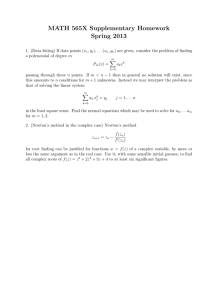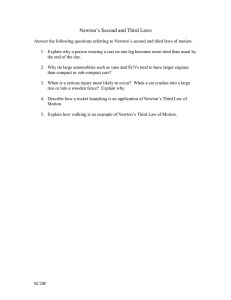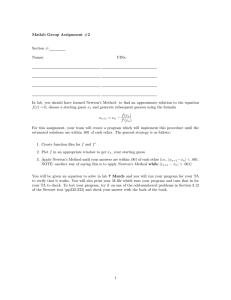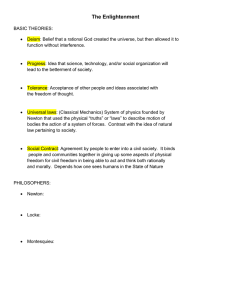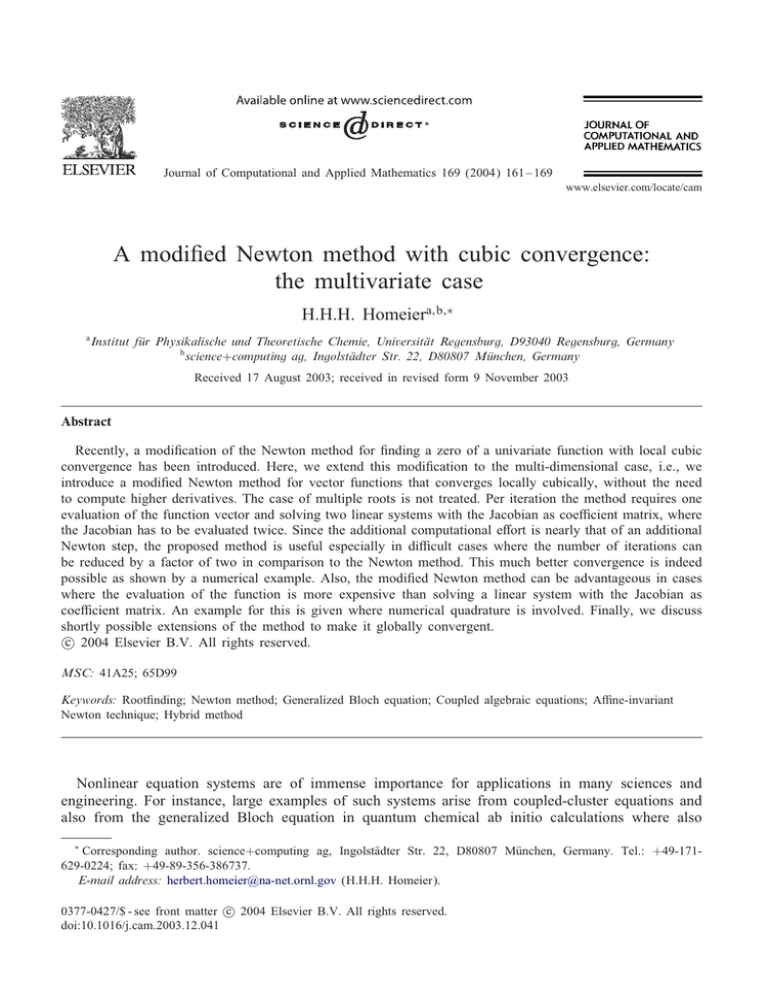
Journal of Computational and Applied Mathematics 169 (2004) 161 – 169
www.elsevier.com/locate/cam
A modi"ed Newton method with cubic convergence:
the multivariate case
H.H.H. Homeiera; b;∗
a
Institut fur Physikalische und Theoretische Chemie, Universitat Regensburg, D93040 Regensburg, Germany
b
science+computing ag, Ingolstadter Str. 22, D80807 Munchen, Germany
Received 17 August 2003; received in revised form 9 November 2003
Abstract
Recently, a modi"cation of the Newton method for "nding a zero of a univariate function with local cubic
convergence has been introduced. Here, we extend this modi"cation to the multi-dimensional case, i.e., we
introduce a modi"ed Newton method for vector functions that converges locally cubically, without the need
to compute higher derivatives. The case of multiple roots is not treated. Per iteration the method requires one
evaluation of the function vector and solving two linear systems with the Jacobian as coe5cient matrix, where
the Jacobian has to be evaluated twice. Since the additional computational e7ort is nearly that of an additional
Newton step, the proposed method is useful especially in di5cult cases where the number of iterations can
be reduced by a factor of two in comparison to the Newton method. This much better convergence is indeed
possible as shown by a numerical example. Also, the modi"ed Newton method can be advantageous in cases
where the evaluation of the function is more expensive than solving a linear system with the Jacobian as
coe5cient matrix. An example for this is given where numerical quadrature is involved. Finally, we discuss
shortly possible extensions of the method to make it globally convergent.
c 2004 Elsevier B.V. All rights reserved.
MSC: 41A25; 65D99
Keywords: Root"nding; Newton method; Generalized Bloch equation; Coupled algebraic equations; A5ne-invariant
Newton technique; Hybrid method
Nonlinear equation systems are of immense importance for applications in many sciences and
engineering. For instance, large examples of such systems arise from coupled-cluster equations and
also from the generalized Bloch equation in quantum chemical ab initio calculations where also
∗
Corresponding author. science+computing ag, IngolstAadter Str. 22, D80807 MAunchen, Germany. Tel.: +49-171629-0224; fax: +49-89-356-386737.
E-mail address: herbert.homeier@na-net.ornl.gov (H.H.H. Homeier).
c 2004 Elsevier B.V. All rights reserved.
0377-0427/$ - see front matter doi:10.1016/j.cam.2003.12.041
162
H.H.H. Homeier / Journal of Computational and Applied Mathematics 169 (2004) 161 – 169
special solution methods have been developed (see, e.g., [12–14,17] and references therein). Despite
the fact that this "eld is researched since decades (see [19] and references therein), there is still room
for new methods. There are problems that are di5cult to tackle using standard solvers [3–8,12–14].
As a generalization of the scalar case [11], we introduce a modi"ed Newton method. Under suitable
conditions it is proved to converge locally cubically. We also present some numerical examples.
Classes of problems are sketched where the modi"ed method might be advantageous. Finally, we
discuss shortly how global convergence could be achieved in analogy to the a5n-invariant Newton
techniques (ANT) of DeuJhard and coworkers [9,10,15,16].
We treat methods for solving the equation F(x(∗) ) = 0 where F : Rd → Rd is a vector function.
The Newton method uses the iteration function
F (x) = x − AF (x)F(x);
where AF (x) = [JF (x)]−1 is the inverse of the Jacobian of F,
@F
; ; = 1::d
JF (x) = DF(x) =
@x x
(1)
(2)
and thus, an iteration sequence x(n+1) = F (x(n) ) is obtained for some starting value x(0) . Since
F(x(∗) ) = 0 entails DF (x(∗) ) = 0, the convergence to the "xed point x(∗) of F , i.e., to the root
x(∗) of F is locally quadratic if the Jacobian matrix JF (x(∗) ) is invertible. Thus, for e(n) = x(n) − x(∗) ,
we have e(n+1) = O(e(n) 2 ). It is well-known, that one can avoid the computation of the matrix
inverse AF (x) by solving a linear system with the Jacobian as coe5cient matrix, and thus, Eq. (1)
is to be regarded as a more formal de"nition.
In the sequel, we consider only the case that JF (x(∗) ) is invertible. Thus, modi"cations of the
Newton method for multiple roots will not be treated in the present contribution.
In the univariate case, the following theorem was proven recently [11]:
Theorem 1. Assume that the function f : R → R is su8ciently smooth in a neighborhood of its root
x∗ , where f (x∗ ) = 0, that the iteration function f : x → x − f(x)=f (x − f(x)=(2f (x))) satis9es
|f (x)| 6 M for some constant M in that neighborhood. Then the iterative scheme x n+1 = f (x n )
converges cubically to x∗ in a neighborhood of x∗ .
The multivariate analogon to the iterative scheme given in the above theorem is given by the
scheme x(n+1) = F (x(n) ) starting from some initial vector x(0) . Here, we de"ne F : x → F (x) by
x
→ z
:
JF (x)(x − z) = F(x)=2;
(x; z) → F (x) : JF (z)(x − F (x)) = F(x):
(3)
Thus, the "rst of these equations is used to calculate an intermediate vector z by solving a linear
system with a coe5cient matrix as given by the Jacobian at x, and then, the new vector F (x) is
calculated by solving a further linear system with a coe5cient matrix as given by the Jacobian at
the vector z.
Formally, we can write
F (x) = x − AF x − 12 AF (x)F(x) F(x):
(4)
H.H.H. Homeier / Journal of Computational and Applied Mathematics 169 (2004) 161 – 169
163
This may be interpreted geometrically in the following way: The tangent hyperplane going through
the point P = (x; F(x)) that is used in the Newton method, is replaced by a hyperplane through P
that is parallel to the tangent hyperplane at Q = (z; F(z)), where z corresponds to a “half Newton
step”. In this way, the curvature of F in the direction of the Newton step is taken into account.
Note that F(z) is not computed.
Now we prove the main result of this contribution:
Theorem 2. Assume that the function F : Rd → Rd has a root x(∗) where the Jacobian JF (x(∗) ) is
invertible. Further, assume that F is su8ciently smooth in a neighborhood of this root such that,
for all x in that neighborhood, the Jacobian JF (x) is invertible with inverse AF (x), the Newton
method converges quadratically and, further
@3 F
(x) 6 M
max 16
;;6d @x
@x @x
for some constant M holds in that neighborhood. Then the iterative scheme
x(n+1) = F (x(n) ) = x(n) − AF x(n) − 12 AF (x(n) )F(x(n) ) F(x(n) )
(5)
converges cubically to x(∗) in a neighborhood of x(∗) .
Proof. De"ne z (n) = x(n) − AF (x(n) )F(x(n) )=2, e(n) = x(n) − x(∗) , and d(n) = z (n) − x(∗) . Then, since the
Newton method converges quadratically, we have x(n) − AF (x(n) )F(x(n) ) = x(∗) + O(e(n) 2 ), whence
z (n) = x(n) =2 + x(∗) =2 + O(e(n) 2 ) :
Thus,
d(n) = e(n) =2 + O(e(n) 2 ):
Using Taylor expansion, we have (we always sum over all double greek indices from 1 to d and
put @
= @=@x
)
F
(x(n) ) = e(n) @ F
(x(∗) ) + 12 e(n) @ e(n) @ F
(x(∗) ) + O(e(n) 3 )
and
@ F
(x(∗) ) = @ F
(z (n) ) − d(n) @ @ F
(z (n) ) + O(d(n) 2 ):
Substituting the latter equation into the "rst term of the rhs of the former equation, and using
1
2
e(n) e(n) (@ @ F
(x(∗) ) − @ @ F
(z (n) )) = O(e(n) 3 );
we obtain
F
(x(n) ) = e(n) @ F
(z (n) ) + O(e(n) 3 ):
But since we have
F
(x(n) ) = (x(n) − x(n+1) ) @ F
(z (n) )
164
H.H.H. Homeier / Journal of Computational and Applied Mathematics 169 (2004) 161 – 169
we obtain by subtracting both relations
0 = e(n+1) @ F
(z (n) ) + O(e(n) 3 ):
Since J (z (n) ) is invertible for z (n) su5ciently close to x(∗) , we obtain the desired result
e(n+1) = O(e(n) 3 ):
This ends the proof.
Now, numerical examples are given for which both the Newton and the modi"ed Newton method
will be compared. The calculations were done using MAPLE VTM 5 [1,2] on a personal computer
requiring 16 decimal digits for all numerical evaluations.
In the "rst example, F corresponds to a coupled system of quadratic equations. It concerns the
so-called generalized Bloch equation (see, e.g., [17]). This equation is used in quantum chemical ab
initio calculations and can also be solved by direct iteration [12–14]. The generalized Bloch equation
can be expressed as
UHU = HU
(6)
in terms of m × m matrices U and H , where H is Hermitean and U is idempotent U 2 = U .
We set (block matrix notation)
1k
0k ×(m−k)
U=
;
X 0(m−k)×(m−k)
where 1k denotes the k × k
(m − k) × k matrix
x1
xm−k+1
xm−k+2
x2
X = .
..
..
.
xm− k
x2(m−k)
(7)
unit matrix, 0u×v denotes the u × v matrix of zeroes, and X is the
···
···
..
.
···
xd−m+k+1
xd−m+k+2
..
.
(8)
xd
with d = (m − k)k. Then, U 2 = U is satis"ed automatically. Also note the special notation for the
entries of the matrix X that shows that X may be regarded as a d dimensional vector x. Inserting this
into Eq. (6), one easily obtains a set of d coupled quadratic equations in the unknowns x1 ; : : : ; xd .
In our example, we put
1
:
(9)
Hi; j =
1 + |i − j|=40
We consider two cases:
Case 1: m = 6; k = 2 which results in d = 8, iterations are stopped for UHU − HU 6 10−14 .
Case 2: m = 8; k = 3 which results in d = 15, iterations are stopped for UHU − HU 6 10−13 .
In all cases and for both the Newton and the modi"ed Newton method, we start from x(0) = 0.
The results for both cases are displayed in Table 1.
First, we discuss Case 1: Here, the estimates for the matrix X at the end agree to approximately
13 decimal digits.
H.H.H. Homeier / Journal of Computational and Applied Mathematics 169 (2004) 161 – 169
165
Table 1
Displayed are the error norms UHU − HU for the Newton and the modi"ed Newton method after the iteration step for
both cases
Case 1
Case 2
Step
Newton
Mod. Newton
Newton
Mod. Newton
1
2
3
4
5
6
7
8
9
10
11
12
13
14
15
16
17
18
19
20
21
3.65
0.64
0.090
1.42
0.33
0.066
0.031
0.0046
0.00031
0.000011
0.13·10−7
0.19·10−13
0.20·10−14
1.42
0.033
0.011
0.00019
0.12·10−8
0.25·10−14
9.86
1.93
0.27
5630.99
1407.75
351.93
87.95
21.95
5.45
1.33
0.30
59.37
14.87
3.74
0.95
0.24
0.091
0.020
0.00072
0.92·10−6
0.46·10−13
2.34
0.24
0.0047
0.00032
0.12·10−6
0.29·10−14
The modi"ed Newton method is slightly superior to the Newton method in case 1 in two respects:
To achieve convergence with 6 steps of the modi"ed Newton method requires similar but somewhat
lower numerical e7orts than 12 steps of the Newton methods since 6 evaluations of F are saved.
Further, the reduction of the error norm is smoother for the modi"ed Newton method.
In Case 2, both methods yield a solution, but these are di7erent. This is not surprising since the
solution to a set of coupled algebraic equations does not need to be unique (nor real). The resulting
approximation for x(∗) is much closer to the starting vector x(0) = 0 in the modi"ed Newton method.
This corresponds to the fact, that again, the decrease of the error norm is much smoother for the
modi"ed Newton method. The Newton method seems to be more likely to run into problems that
result in a ragged performance pro"le in terms of the error norm. As a result of this behavior, for
case 2, the modi"ed Newton method is much superior to the Newton method since the numerical
e7ort for the 6 iteration steps is somewhat less than that of 12 iteration steps of the Newton method.
As a second example, we treat the two-dimensional vector function F with components
x+3y −1
F1 : (x; y) →
1 + exp 2 8 |t|
dt + xy;
0
F2 : (x; y) → exp(−x) − exp(−4y):
(10)
166
H.H.H. Homeier / Journal of Computational and Applied Mathematics 169 (2004) 161 – 169
Table 2
Displayed are the error norms x(n) for the Newton and the modi"ed Newton method for the vector function (10), and
the total execution times up to iteration n (for a representative run using numerical quadrature, in seconds). The starting
vector was (2; 0:6)
Newton
Mod. Newton
n
Error
Time
Error
Time
1
2
3
4
5
6
7
8
9
10
11
12
13
1.12
8.58·10−2
1.58·10−2
4.37·10−3
3.09·10−4
1.87·10−5
7.35·10−7
1.78·10−8
2.55·10−10
2.05·10−12
8.75·10−15
3.45·10−17
1.59·10−17
8
16
24
33
41
50
59
67
76
84
93
101
110
3.02·10−1
1.08·10−2
7.30·10−5
7.05·10−7
3.84·10−9
1.07·10−11
1.39·10−14
4.72·10−18
9
17
25
34
42
51
59
69
Table 3
Displayed are the error norms x(n) for the Newton and the modi"ed Newton method for the vector function (10), and
the total execution times up to iteration n (for a representative run using the analytical expression, in seconds). The
starting vector was (2; 0:6)
Newton
Mod. Newton
n
Error
Time
Error
Time
1
2
3
4
5
6
7
8
9
10
11
1.12
8.58·10−2
1.58·10−2
4.37·10−3
3.09·10−4
1.87·10−5
7.35·10−7
1.78·10−8
2.55·10−10
2.23·10−12
2.73·10−14
0
1
1
1
2
2
3
3
4
6
6
3.02·10−1
1.08·10−2
7.30·10−5
7.05·10−7
3.84·10−9
1.11·10−11
1.20·10−13
0
1
1
2
2
3
3
This function has a zero at (0,0). In Tables 2 and 3, we compare the Newton method and the
present modi"cation. Although an analytical expression for the integral in F1 is available,
z
−1
√
1 + exp 2 8 |t|
dt = z + 315 8 z "(7; −X ) − 4z 7=8 ln(1 + X )
0
H.H.H. Homeier / Journal of Computational and Applied Mathematics 169 (2004) 161 – 169
167
315
"(8; −X ) − 14z 3=4 "(2; −X )
2
√
+42z 5=8 "(3; −X ) − 105 z"(4; −X )
√
+210z 3=8 "(5; −X ) − 315 4 z "(6; −X )
−
127 8
#
7680
√ for X = exp 2 8 z and z ¿ 0, in terms of the polylog function denoted by
∞ n
r
"(a; r) =
;
na
n=1
−
(11)
(12)
we "rst evaluate the integral by numerical quadrature for illustrative purposes (Table 2).
Then, the time per iteration is strongly dominated by the numerical quadrature of the integral in
F1 . Hence, the time per iteration is nearly equal for the Newton and the modi"ed Newton method.
The modi"ed method is seen to be superior in this example. To reach comparable accuracies requires
about 50–70% more computational time for the Newton method.
If the analytical expression is used instead, we obtain the results in Table 3. Apart from much
lower overall execution times, more or less the same picture as in Table 2 is observed. This means
that the evaluation of the vector function is still rather costly in comparison to the other operations
required for a Newton step.
Of course, the second example is especially chosen to illustrate the potential of the modi"ed
Newton method.
However, the modi"ed method is expected to be at least competitive to the Newton method (as
in the one-dimensional case) if the costs for the evaluation of the vector function are comparable
to the costs for the evaluation of the Jacobian and the solution of the corresponding linear systems.
Under such conditions, two steps of the modi"ed method and three steps of the Newton method
have approximately the same costs and the same order of convergence: Starting at a distance ' from
x(∗) the error is O('6 ) both after two steps of the modi"ed method or after three steps of the Newton
method.
Such cost relations can occur for instance (a) in low-dimensional problems, (b) in cases where
the Jacobian is sparse, (c) for Jacobians of a special structure (banded, triangular etc.) making
inversion or solution of the corresponding linear systems cheap and (d) in cases involving numerical
quadrature similar to the second example.
It is not claimed that the present modi"cation of the Newton method is always superior to the
Newton method.
In many cases, the evaluation of the vector function F costs much less than the evaluation of the
Jacobian and/or the solution of the corresponding linear systems. This means that the costs for one
step of the modi"ed Newton method are approximately equal to that of two steps of the Newton
method. Starting at a distance ' to x(∗) the error after one step of the modi"ed method is O('3 ) and
after two steps of the Newton method is O('4 ) for small '. Thus, close to x(∗) , the Newton method
should be superior.
But as noted for the "rst example, the modi"ed Newton method may provide a smoother decrease
of the error norm than the Newton method. A better understanding of such a behavior at larger
168
H.H.H. Homeier / Journal of Computational and Applied Mathematics 169 (2004) 161 – 169
distances from x(∗) would be very interesting. Such an investigation should provide conditions under
which a single step of the modi"ed method can be superior to two steps of the Newton method.
The search for such conditions is a promising line for future work.
It is to be expected that there are cases where the modi"ed method has problems similar to the
Newton method, e.g., due to the fact that the Jacobian is numerically singular. Thus, in order to use
the present method in a robust solver, one has to combine it with other concepts such as trust regions
or steepest descent methods, similar to hybrid methods involving the Newton method like Powell’s
method [18] or like HYBRD1 from MINPACK, available from NETLIB. Even more promising is
the use of ANT of DeuJhard and coworkers [9,10,15,16] that can be used to make the Newton
method globally convergent. There, one uses a carefully chosen damping factor ( with 0 ¡ ( 6 1
to reduce the Newton step in such a way that too large steps are avoided. This damping strategy is
chosen to be a5n-invariant. This means that for any invertible matrix M ∈ GL(d) and any starting
vector x(0) the application of the method to the vector function G(x) = MF(x) will yield the same
sequence of iterates x(n) as application to F(x) itself.
We note that, similarly to the Newton method, the modi"ed Newton method (without damping)
is a5ne invariant. The proof is straightforward and left to the reader. Thus, one may use all the
concepts of DeuJhard’s ANT also for the modi"ed method with probably small modi"cations. This,
however, is beyond the scope of the present contribution.
Acknowledgements
The author thanks the Deutsche Forschungsgemeinschaft and the Fonds der Chemischen Industrie
for "nancial support.
References
[1] B.W. Char, K.O. Geddes, G.H. Gonnet, B.L. Leong, M.B. Monagan, S.M. Watt, Maple V Language Reference
Manual, Springer, Berlin, 1991.
[2] B.W. Char, K.O. Geddes, G.H. Gonnet, B.L. Leong, M.B. Monagan, S.M. Watt, Maple V Library Reference Manual,
Springer, Berlin, 1991.
[3] D. Dent, M. Paprzycki, A. Kucaba-Pietal, Performance of solvers for systems of nonlinear equations, in: Proceedings
of the 15th Annual Conference on Applied Mathematics, University of Central Oklahoma, Edmond, OK, 1999,
pp. 67–77.
[4] D. Dent, M. Paprzycki, A. Kucaba-Pietal, Studying the numerical properties of solvers for systems of nonlinear
equations, in: D. Bainov (Ed.), Proceedings of the Ninth Colloquium on Di7erence Equations, Utrecht, VSP, 1999,
pp. 113–118.
[5] D. Dent, M. Paprzycki, A. Kucaba-Pietal, Testing convergence of nonlinear system solvers, in: Proceedings of the
First Southern Symposium on Computing, The University of Southern Mississippi, December 4–5, 1998, 1999.
http://pax.st.usm.edu/cmi/fscc98 html/processed/.
[6] D. Dent, M. Paprzycki, A. Kucaba-Pietal, Recent advances in solvers for nonlinear algebraic equations, Comput.
Assist. Mech. Eng. Sci. (CAMES) 7 (2000) 493–505.
[7] D. Dent, M. Paprzycki, A. Kucaba-Pietal, Studying the performance nonlinear systems solvers applied to the
random vibration test, in: Svetozar Margenov, Jerzy Wasniewski, Plamen Y. Yalamov (Eds.), Large-Scale Scienti"c
Computing, Third International Conference, LSSC 2001, Sozopol, Bulgaria, June 6–10, 2001, Revised Papers, Lecture
Notes in Computer Science, Vol. 2179, Springer, Berlin, 2001, pp. 471–478.
H.H.H. Homeier / Journal of Computational and Applied Mathematics 169 (2004) 161 – 169
169
[8] D. Dent, M. Paprzycki, A. Kucaba-Pietal, Comparing solvers for large systems of nonlinear algebraic equations, in:
Proceedings of the Southern Conference on Computing, The University of Southern Mississippi, October 26–28,
2000, 2002. http://www.sc.usm.edu/conferences/scc2/papers/Dent-etal.ps.
[9] P. DeuJhard, A modi"ed Newton method for the solution of ill-conditioned systems of nonlinear equations with
application to multiple shooting, Numer. Math. 22 (1974) 289–315.
[10] P. DeuJhard, A relaxation strategy for the modi"ed Newton method, in: R. Bulirsch, W. Oettli, J. Stoer (Eds.),
Optimization and Optimal Control, Lecture Notes in Mathematics, Vol. 477, Springer, Berlin, 1975, pp. 59–73.
[11] H.H.H. Homeier, A modi"ed Newton method for root "nding with cubic convergence, J. Comput. Appl. Math. 157
(2003) 227–230.
[12] H. MeiTner, J. Paldus, Direct iterative solution of the generalized Bloch equation. II. A general formalism for
many-electron systems, J. Chem. Phys. 113 (7) (2000) 2594–2611.
[13] H. MeiTner, J. Paldus, Direct iterative solution of the generalized Bloch equation. III. Application to H2 -cluster
models, J. Chem. Phys. 113 (7) (2000) 2612–2621.
[14] H. MeiTner, J. Paldus, Direct iterative solution of the generalized Bloch equation. IV. Application to H2 LiH, BeH,
and CH2 , J. Chem. Phys. 113 (7) (2000) 2622–2637.
[15] U. Nowak, L. Weimann, GIANT—a software package for the numerical solution of very large systems of highly
nonlinear equations, Technical Report TR 90-11, Konrad-Zuse-Zentrum fAur Informationstechnik, Berlin, 1990.
available from the ZIB ftp-server.
[16] U. Nowak, L. Weimann, A family of Newton codes for systems of highly nonlinear equations, Technical Report TR
91-10, Konrad-Zuse-Zentrum fAur Informationstechnik, Berlin, 1991. available from the ZIB ftp-server.
[17] J. Paldus, Coupled cluster theory, in: S. Wilson, G.H.F. Diercksen (Eds.), Methods in Computational Molecular
Physics, Plenum Press, New York, 1992, pp. 99–194.
[18] M.J.D. Powell, A hybrid method for nonlinear equations, in: P. Rabinowitz (Ed.), Numerical Methods for Nonlinear
Algebraic Equations, Gordon and Breach, London, 1970, pp. 87–114.
[19] W.C. Rheinboldt, Methods for Solving System of Nonlinear Equations, SIAM, Philadelphia, 1998.


